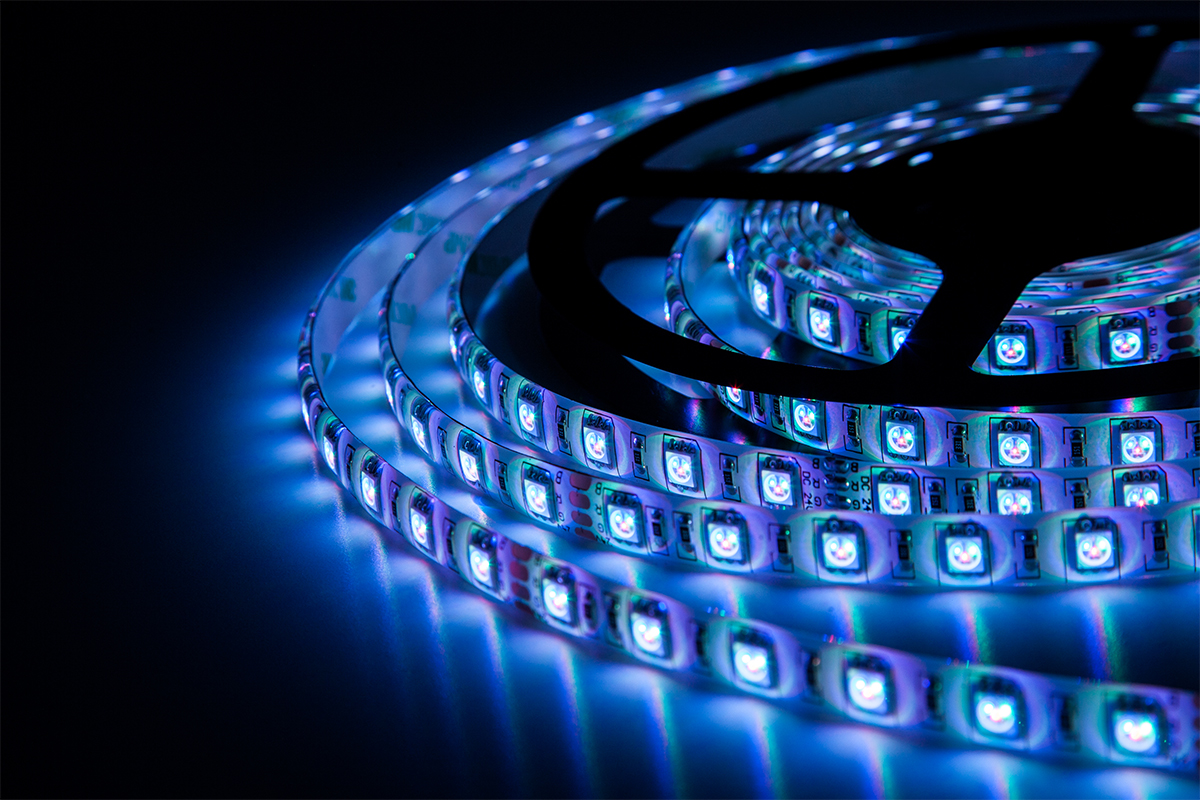Table of Contents Hide

What is a smart LED strip light
A smart LED strip light refers to a type of LED strip that is equipped with connectivity options such as Wi-Fi, Bluetooth, or Zigbee, allowing them to be remotely operated through a mobile app, voice-activated virtual assistants, or smart home platforms. Smart LED strip lights come with a variety of advanced features that enhance their functionality, flexibility, and convenience. They can be controlled and programmed through digital interfaces for creating dynamic and personalized lighting experiences in homes, offices, entertainment areas, and various other environments.Smart lighting controller
Smart LED strips leverage a combination of wireless connectivity, microcontrollers, and mobile apps to offer users advanced control and automation features for their lighting setups. Built-in microcontrollers or processors serve as the brains of smart LED strips. These devices process commands, manage communication with external devices, and control the individual LEDs on the strip. The choice of controllers depends on the specific features and functionalities desired. These controllers offer wireless connectivity, smartphone or web-based control interfaces, integration with smart home/building ecosystems, and IoT capabilities for data-driven applications. Addressable smart LED strips, which include LEDs that can be individually controlled and programmed, often use microcontroller-based lighting controllers for dynamic color-changing effects, animations, and patterns. Non-addressable LED strips, such as those using common analog RGB LEDs, typically use simpler controllers.Wireless connectivity
Smart LED strips are designed to work with wireless communication protocols, allowing them to connect to other devices and networks such as smartphones, tablets, or smart home systems. This wireless capability enables remote control and automation of lighting without physically interacting with the strips.Using Wi-Fi for smart LED strips is a common and convenient choice. Wi-Fi provides a long-range connection, allowing control from a considerable distance. Wi-Fi's high bandwidth enables fast and responsive communication between the control device (e.g., smartphone or tablet) and the LED strips. No additional hubs or gateways are required for basic functionality, making the setup straightforward. Wi-Fi connectivity can be more power-hungry compared to some other wireless options, potentially affecting the overall energy efficiency of the LED strips.
Bluetooth Mesh, a communication protocol built on Bluetooth Low Energy (BLE) technology, is a robust choice for smart LED strips, offering a balance between scalability, reliability, and user-friendly control options. Bluetooth Mesh-enabled LED strips supports mesh networking and interoperability among devices from different manufacturers that adhere to the standard. Direct device-to-device communication reduces the need for all messages to go through a central hub, which can improve efficiency.
ZigBee is another mesh networking protocol that features extended range and improved reliability as signals can hop between devices. A central hub must be deployed within a ZigBee network in order to enable end users to control it with a smartphone. Like Zigbee, Z-Wave supports mesh networking, enhancing range and reliability. A dedicated hub is required for communication.
The connectivity option for smart LED strip lights depends on factors such as the desired range, integration with other smart devices, power consumption considerations, and personal preferences in terms of control methods. Many modern smart LED strips support multiple connectivity options, offering flexibility for users.
Digital LED strips vs analog LED strips
Digital LED strips and analog LED strips differ in how they control and address individual LEDs, which impacts their capabilities and applications. Digital LED strips use addressable LEDs, such as WS2812, WS2813, and APA102, for highly customizable and intricate lighting effects. Each LED on the strip is individually addressable, which means that the individual LEDs on the strip can display different color or intensities simultaneously. These smart LED strips can be programmed to create advanced color effects, animations, and patterns. Digital LED strips are more complex to control due to the need for precise addressing of each LED. They require specific controllers that support the communication protocol of the addressable LEDs. Microcontrollers, such as those found in Arduino, Raspberry Pi, or other embedded systems, are often employed for their programmability and versatility. Digital LED strips are therefore generally more expensive due to the additional complexity and individual control capabilities.In analog LED strips, all LEDs share the same color and brightness settings, and they are controlled globally, meaning that changes in color or brightness apply to the entire strip simultaneously. Analog LED strips are limited in terms of dynamic effects. They can typically display static colors, color fades, or simple patterns. They are suitable for applications where uniform lighting is sufficient, such as accent lighting, backlighting, or basic decorative lighting. These LED strips typically do not require a microcontroller for basic operation. They can be controlled using standard LED controllers that operate on common constant current reduction (CCR) or pulse width modulation (PWM) signals.
Color configuration
Smart LED strip lights come in various types based on their color configuration and capabilities. White light LED strips are offered in a range of color temperatures. Monochrome LED strips come in single colors such as red, green, blue, or white. They are suitable for applications where a specific color is desired without the need for complex color-changing effects. Tunable white LED strips allow users to adjust the color temperature of the white light from warm white to cool white. Dim-to-Warm LED strips are designed to mimic the color temperature changes of traditional incandescent bulbs as they are dimmed.RGB LED strips consist of individual LEDs capable of emitting red (R), green (G), and blue (B) light. These three primary colors can be mixed in various ratios to produce a wide spectrum of colors. RGBW LED strips incorporate an additional white LED alongside the red, green, and blue LEDs to create better-quality whites compared to RGB ED strips. It also enables saturated reds, and a full range of pastels. RGBA LED strips with red, green, blue, and amber LEDs expand the available range of colors to include warmer tones. RGBWW LED strips extend the color configuration by adding a second white LED with a different color temperature. RGB+CCT LED strips combine RGB color control with adjustable white color temperature.
RGBIC LED strips, which stands for Red, Green, Blue, and Independent Control, are a type of digital addressable LED strip lights that allow for individual control of multiple sections or segments along the strip. This technology enhances the dynamic lighting capabilities of RGB LED strips. RGBIC+CCT LED strips integrate both independent control of each LED and adjustable color temperature.








